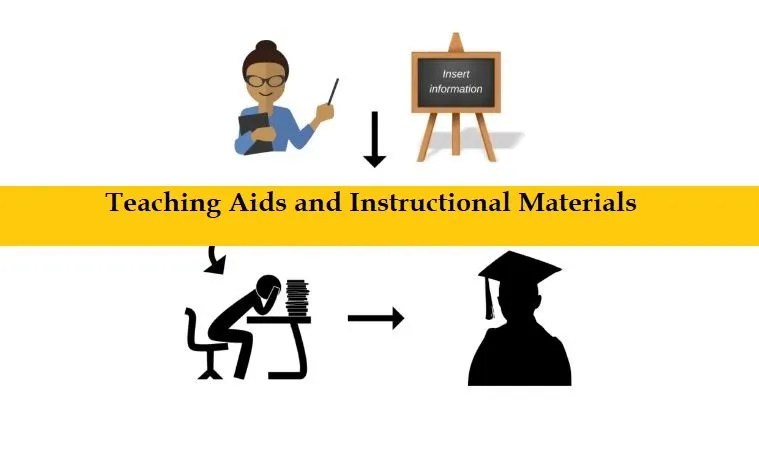
This article breaks down the meaning, differences, type and examples of teaching aids and instructional materials. Sadly, some tutors confuse these 2 terms and apply them wrong.
Upon reading this article carefully, you should be able to differentiate between teaching aids and instructional materials, meaning, examples as well as benefits of applying both where needed.
What are Teaching Aids?
Teaching aids are materials or tools that are used by teachers to enhance the teaching and learning process. They can be visual, auditory, or kinesthetic in nature, and can be used to reinforce a concept, clarify a complex idea, or stimulate interest in a particular subject.
Teaching aids are more connected to the teacher because it aids him or her in passing knowledge easily to the pupils.
10 common types of teaching aids include:
- Whiteboards and markers
- Chalkboards and chalk
- Computer projectors and PowerPoint presentations
- Videos and DVDs
- Charts and graphs
- Flashcards and posters
- Models and manipulatives
- Interactive whiteboards
- Audio recordings and music
- Whiteboards and markers: Whiteboards and markers are a common teaching aid used in classrooms and other learning environments. A whiteboard is a smooth, glossy surface that can be written on with dry-erase markers, which can be easily erased with a cloth or eraser
- Chalkboards and chalk: Chalkboards and chalk are traditional teaching aids that have been used for many years in classrooms. A chalkboard is a flat surface that can be written on with chalk, which is a soft, white stick made of compressed gypsum or calcium carbonate
- Overhead projectors and transparencies: Overhead projectors and transparencies are another common teaching aid that has been widely used in classrooms. An overhead projector is a device that projects images onto a screen or wall from a transparent film or sheet, called a transparency, that has been placed on the projector’s surface.
- Computer projectors and PowerPoint presentations: Computer projectors and PowerPoint presentations have become increasingly popular as teaching aids in recent years. A computer projector is a device that projects the images from a computer onto a screen or wall, allowing the teacher to display text, images, and videos to the class. PowerPoint is a software program developed by Microsoft that allows users to create multimedia presentations.
- Videos and DVDs: Videos and DVDs are another common teaching aid used in classrooms and other learning environments. They can be used to present visual and auditory content to students, making the learning experience more engaging and memorable.
- Charts and graphs: Charts and graphs are commonly used visual aids in teaching, particularly in subjects such as math, science, and social studies. Charts and graphs can be used to represent data, trends, and relationships in a visually appealing and easy-to-understand format
- Flashcards and posters: Flashcards and posters are commonly used teaching aids in classrooms, particularly in language learning and early childhood education. Flashcards are small cards with information on them that can be used to teach vocabulary, grammar, and other concepts. Posters are larger visuals that can be used to display information and reinforce concepts.
- Models and manipulatives: Models and manipulatives are teaching aids that provide a hands-on approach to learning. Models are three-dimensional representations of objects, while manipulatives are objects that can be physically manipulated by learners. These teaching aids can be used in a variety of subjects, such as science, math, and art.
- Interactive whiteboards: Interactive whiteboards are an advanced form of traditional whiteboards that allow for a more interactive and engaging learning experience. They are electronic displays that can be connected to a computer or tablet, and allow users to interact with digital content using a special pen or their fingers.
- Audio recordings and music: Audio recordings and music are commonly used teaching aids in classrooms and other learning environments. They can be used to present information and reinforce concepts in a way that is engaging and memorable for students.
Teaching aids can be an effective way to engage students and make learning more interactive and enjoyable. They can help students to understand concepts more easily and can also cater to different learning styles, such as visual or auditory learners. However, it is important to use teaching aids in a way that enhances the learning experience, rather than relying on them too heavily or using them as a substitute for quality teaching.
Now you know what teaching aids are and the list of examples available.
Can we now read through instructional materials?
What are Instructional Materials?
Instructional materials are tools or resources that are used to facilitate teaching and learning. They can be physical, digital, or a combination of both, and can be used to support and supplement lessons and activities.
9 Examples of instructional materials include:
- Textbooks and workbooks
- Handouts and worksheets
- Online resources and e-books
- Interactive multimedia programs and simulations
- Learning management systems and online courses
- Games and puzzles
- Manipulatives and models
- Visual aids and diagrams
- Real-life objects and artifacts
- Audio recordings and podcasts
- Handouts and worksheets: Handouts and worksheets are commonly used teaching aids in classrooms, particularly in subjects such as math, language, and social studies. Handouts are sheets of paper with information or instructions on them that are distributed to students, while worksheets are similar but include exercises or activities to reinforce concepts.
- Online resources and e-books: Online resources and e-books are increasingly popular teaching aids that have become widely used in classrooms and other learning environments. Online resources can include websites, videos, interactive simulations, and online games, while e-books are electronic versions of printed books that can be accessed on computers, tablets, or e-readers.
- Interactive multimedia programs and simulations: These are advanced teaching aids and instructional material that provide an immersive and engaging learning experience. They are digital programs that combine text, images, video, and interactive elements to teach concepts and reinforce learning. Simulations are specifically designed to replicate real-world situations or processes in a controlled and safe environment.
- Learning management systems and online courses: These are modern teaching aids that provide an online platform for delivering educational content and managing student progress. LMSs can be used to deliver and manage traditional classroom-based courses, as well as fully online courses.
- Games and puzzles: These are another type of instructional that can be used to make learning more enjoyable and interactive. Games are activities that involve competition, while puzzles are activities that require problem-solving skills. They can be used in a variety of subjects, such as math, language, and social studies.
- Manipulatives and models: These are methods that aid teaching especially in the area of mathematics. This is an instructional material provide a hands-on approach to learning. Manipulatives are objects that can be physically manipulated by learners, while models are three-dimensional representations of objects.
- Visual aids and diagrams: This is an instructional material that provide a visual representation of information and concepts. They can help students understand complex information and make connections between ideas. Visual aids can include posters, charts, graphs, and diagrams, while diagrams can be used in subjects such as science, math, and language arts.
- Real-life objects and artifacts: This instructional material which also serves as a teaching aid helps bring the subject matter to life and make it more tangible for students. They can be used to provide a real-world context for learning and to help students understand the practical applications of what they are learning. Real-life objects can include items such as historical artifacts, natural specimens, and scientific instruments, while artifacts can be used in subjects such as social studies, science, and art.
- Audio recordings and podcasts: These are teaching aids and instructional materials for teachers that provide an auditory approach to learning. They can be used to present information and reinforce concepts in a way that is engaging and memorable for students. Audio recordings can include lectures, interviews, and storytelling, while podcasts are digital audio files that can be downloaded and listened to at any time.
Instructional materials can be used to introduce new concepts, reinforce learning, provide practice opportunities, and assess understanding. They can also help to accommodate different learning styles and needs, and make lessons more engaging and interactive. However, it is important to choose appropriate instructional materials that align with the learning objectives and cater to the needs of the learners, and to use them effectively and efficiently in the teaching and learning process.
Differences Between Teaching Aids and Instructional Materials
The terms “teaching aids” and “instructional materials” are often used interchangeably, but there is a subtle difference between the two.
Teaching aids are resources that are used by teachers to support the delivery of a lesson or activity. They are designed to enhance the learning experience by making it more engaging and interactive. Teaching aids can be visual, auditory, or kinesthetic in nature, and can include items such as whiteboards, charts, models, manipulatives, videos, and audio recordings.
Instructional materials, on the other hand, are resources that are used to facilitate learning. They are designed to provide information, instruction, and practice opportunities to learners. Instructional materials can be physical, digital, or a combination of both, and can include items such as textbooks, workbooks, handouts, online resources, multimedia programs, and games.
Benefits of Teaching Aids and Instructional Materials
Teaching aids and instructional materials can provide numerous benefits for both teachers and students. Here are some of the benefits:
- Enhanced learning: Using teaching aids and instructional materials can help students better understand and retain information by providing a more engaging and interactive learning experience.
- Improved student engagement: Teaching aids and instructional materials can capture students’ attention and make learning more enjoyable, leading to increased student engagement and participation.
- Personalized learning: Using teaching aids and instructional materials can allow for a more personalized learning experience, as students can work at their own pace and in their own preferred style.
- Differentiation: Teaching aids and instructional materials can be used to differentiate instruction for students with different learning styles and abilities.
- Increased motivation: Teaching aids and instructional materials can increase student motivation by providing a more tangible and practical approach to learning.
- Improved teacher efficiency: Teaching aids and instructional materials can help teachers deliver content more efficiently and effectively, freeing up time for other instructional activities.
Overall, teaching aids and instructional materials can provide a valuable supplement to traditional teaching methods, enhancing the learning experience and improving student outcomes.
In summary, teaching aids are resources used to support the teaching process, while instructional materials are resources used to facilitate the learning process. While there is some overlap between the two, teaching aids tend to be more focused on engaging and motivating learners, while instructional materials tend to be more focused on providing information and opportunities for practice.


